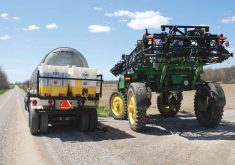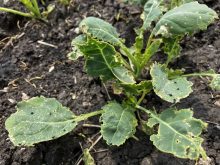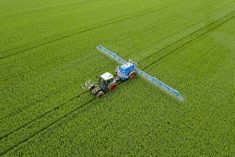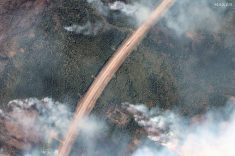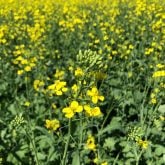In a spray season that has already seen frost warnings, heat waves and high winds, producers in early June were dealing with yet another problem — lack of water.
Water restrictions were making headlines in early June, with some treatment plants reporting worryingly low levels of potable water.
Why it matters: High-quality water is in high demand for best spray results, but this year, local water systems are having a hard time keeping up.
In the Municipality of Oakland-Wawanesa, all residents were urged to restrict water use. As well as drought conditions — at the time, the area had still seen little rain and was well within the area of central and western Manitoba classified as “extreme drought” by Canada’s Drought Monitor — the municipality was also fighting an unidentified water leak, a June 4 notice from the local fire department said.
Read Also

Manitoba boosts stake in cereals centre to $23.5 million
Premier Wab Kinew said the additional project funds will help ‘Trump-proof’ the provincial economy.
In south-central Manitoba, residents were warned that treated water coming out of the Pembina Valley Water Co-operative (PVWC) was reaching critical levels in the first week of June. The co-op, which services much of the Pembina Valley and western Red River Valley, urged its member governments to cut back on water use. Severe drought plans launched in several of those areas, restricting farmers from accessing that water for spraying and irrigation.
Morden residents had already been told as of May 4 to curb water use, as general lack of snow in the area had failed to provide normal recharge for the nearby lake. The lake was six feet, 10 inches below full supply levels at the time of the notice, and local government has since indicated that levels had fallen further.
“Morden and some of those areas, they’re in full restriction mode,” Warren McCutcheon, director with the Manitoba Crop Alliance and a farmer near Carman, said June 8.
In his home Municipality of Dufferin, reducing water use was “more of a suggestion” targeting unnecessary use, he said, although he noted that some dugouts normally tapped for spraying water were also running low.
The area has since seen rain.
In light of the early-June restrictions, the PVWC announced five truck fill sites for agriculture and industry to draw on.
Farmers could haul water from three sites in the western Red River Valley (Morris, Letellier and St. Jean), one near Altona and one near the junction of Hwy. 3 and Hwy. 23.
Don Wiebe, PVWC co-chair and reeve of the RM of Rhineland, cited a two-week period in which demand skyrockets due to spray season.
“Some of our smaller reservoirs were virtually out of water, so this restriction came just in time, and we appreciated people’s co-operation,” he said.
The co-op has since managed to fill those reservoirs.
“If ag producers can find alternatives to potable water, we’ll be OK,” Wiebe said.
The five alternate sites have been sufficient so far and have actually seen less demand than first anticipated, according to Wiebe. He added that some producers are using their own ponds.
Hauling water is “an inconvenience,” he acknowledged, “but (the farmers) recognize the limitations of our system.”
McCutcheon also noted the inconvenience, particularly if fill sites are a distance away.
“That’s not handy when you’re having to worry about getting water,” he said. “Some people don’t use water trucks. If you’re a small farmer, you’re probably based out of your home yard and you kind of run the sprayer back and forth to your home yard, so now you have to put a truck on the road to go get water and bring it back.”
In the RM of Grey, one of the farthest-flung regions to draw on the PVWC, the municipality announced on June 4 that its normal truck fill stations in St. Claude and Haywood would close due to low reservoir levels. In light of the closure, local government opened two temporary pumping sites in Fanystelle and a local gravel pit near St. Claude, as well as untreated water sites at the Rathwell and Elm Creek community wells, for farmers and construction.
Brenda Poulsen, utilities manager for the RM of Grey, said demand at the Elm Creek site was, “very high with long waiting periods,” with “as much as double the gallons being hauled from there this year compared to other years during spray season.”
Some Haywood residents were opting instead for the Elm Creek site, she noted.
Producers in the area often opt for treated water versus their own pond or well water for spraying, she noted, citing an increase in spray efficacy and lower sprayer maintenance.
Water out of the local dugouts is, “not the prettiest stuff, for sure… you’d definitely want to be straining and filtering it at home before you put it in your sprayer and end up with plugging nozzles and stuff like that, compared to just being able to tap into some rural water and whatnot that’s obviously a clean high quality,” McCutcheon said.
At the same time, he argued, many of those quality issues could be worked around if producers were forced to turn to those sources.
The preference for treated water has put a greater demand on the local system year after year, Poulsen said, although she added that some producers have taken to filling tanks overnight, in order to avoid that strain.
“This year the extreme heat brought on early lawn watering needs and more garden watering. Add the fact that COVID has everyone staying home, we have much higher gallons going towards pool filling as well,” she said. “These things on their own can keep a water plant operator scrambling trying to keep the reservoir levels from going too low. Combine this with spraying season and it’s unmanageable.”
In other areas, community wells were also running low in the first week and a half of June.
Henning Wubbe, who farms near La Riviere, noted significant wait times at the local well as pumps struggled to keep up with demand.
“It had got to the point where it couldn’t recharge fast enough and even to load a 3,000-gallon tank on my truck, the pump would kick out halfway through and you would have to wait for it to reset,” he said.
He estimates a fill that would normally take 15 minutes stretched up to an hour.
At the same time, Wubbe said, people from outside the region started travelling to use the La Riviere well.
The Mary Jane Creek, which runs beside the well, was “the lowest I’ve ever seen it,” he added. “There was really, essentially, no water in that creek. It wasn’t even running.”
Rain recharge
The situation has drastically changed, Wubbe added.
Rain late in the second week of June drenched parts of the province that had previously seen little water since last fall. Weather data from the province recorded up to 78 millimetres in a band from La Riviere to the Carman area from June 8-10, while much of central Manitoba in general saw anywhere from 20-40 millimetres.
Parts of the northwest saw similarly heavy rains, although little fell in other regions of western Manitoba or patches of the Interlake.
Time to grow capacity
The recent supply issues highlight a need for more water capacity as demands jump, Wiebe argued.
Raw water supply, he said, is not the issue for the PVWC. Rather, the system is limited by the capacity to produce and store treated water.
The region in general has grown significantly, as has the amount of water drawn out of the co-op’s system, he noted.
In Morden, for example, population grew almost 11 per cent in the five years between 2011 and 2016, according to census data.
Certain agricultural practices have also increased the amount of water used during parts of the year, he said.
“The whole region needs to work on greater capacity and, certainly, alongside that, needs to develop more storage capacity,” he said, citing the construction of a new $2-million reservoir.
Poulsen, meanwhile, suggested it might be time for a look at how water is managed on farm.
“This is a reset for the farming community to rethink their practices again,” she said. “Find other water sources, maintain the water sources they have and come up with innovative ways to filter their well and pond water.”




